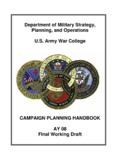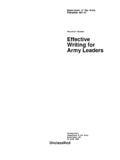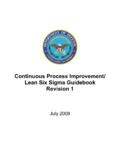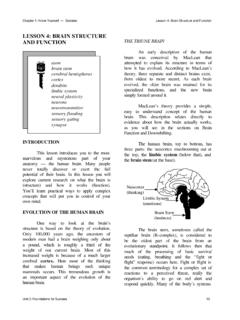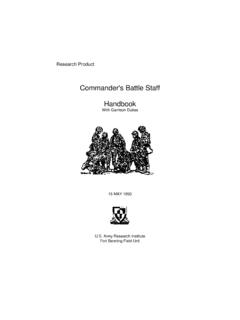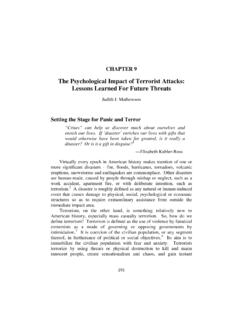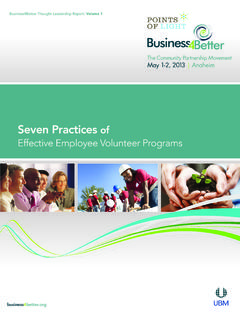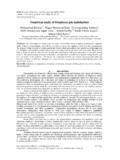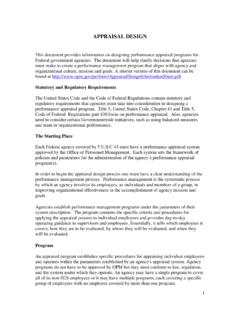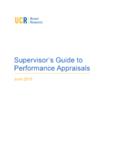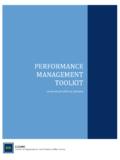Transcription of AHandbookfor Measuring Employee Performance
1 AHandbookforMeasuringEmployeePerformance :AligningEmployeePerformancePlanswithOrg anizationalGoalsPMD-13 RevisedJanuary2001 UnitedStatesOfficeofPersonnelManagementW orkforceCompensationandPerformanceServic eTable of 1 Performance Management: Background and 2 Distinguishing Activities From Fable of the Beekeepers and Their Balanced Measuring Word About Categories of 3 Developing Employee Performance 1 Look at the Overall 2 Determine Work Unit A: Goal Cascading B: Customer-Focused C: Work Flow 3 Determine Individual 4 Convert Accomplishments Into Performance 5 Determine 6 Develop 7 Determine How to Monitor 8 Check the Performance 4 Learning Measurement Quiz With Reference for Developing Performance Plans That Align With Organizational A: Examples of Standards Written at Five B: Examples of Standards Written at Three C.
2 Examples of Standards Written at Two Handbook for Measuring Employee Performance1 ForewordThis handbook is designed for Federal supervi-sors and employees and presents an eight-step process for developing employeeperformance plans that are aligned with andsupport organizational goals. It also providesguidelines for writing Performance elements andstandards that not only meet regulatory require-ments, but also maximize the capability thatperformance plans have for focusing employeeefforts on achieving organizational and methods presented here are designed todevelop elements and standards that measureemployee and work unit accomplishmentsrather than to develop other measures that areoften used in appraising Performance , such asmeasuring behaviors or competencies.
3 Although this handbook includes a discussion ofthe importance of balancing measures, the mainfocus presented here is to measure accomplish-ments. Consequently, much of the informationpresented in the first five steps of this eight-stepprocess applies when supervisors and employ-ees want to measure results. However, thematerial presented in Steps 6 through 8 aboutdeveloping standards, monitoring Performance ,and checking the Performance plan apply toall measurement handbook has four chapters and appendices:CChapter 1 gives the background and contextof Performance management that you willneed to understand before beginning theeight-step process;CChapter 2 defines accomplishments whichis key to using this handbook successfully.
4 CChapter 3 includes a detailed description ofthe eight-step process for developing em-ployee Performance plans that are alignedwith and support organizational 4 provides study tools, including afollowup quiz and a quick reference for theeight-step appendices contain standards intendedto serve as illustrations of standards writtenfor appraisal programs that appraise perfor-mance on elements at five, three, and reading the instructional material, studyingthe examples, and completing the exercises inthis book, you should be able to:Cdevelop a Performance plan that aligns indi-vidual Performance to organizational goals;Cuse a variety of methods to determine workunit and individual accomplishments;Cdetermine the difference between activitiesand accomplishments.
5 AndCexplain regulatory requirements for Employee Performance Management Practitioner Series2 This page left Handbook for Measuring Employee Performance3 Performance Management s Five Key ComponentsChapter 1 Performance Management:Background and ContextRemember the story about the naive studentin his first English literature course who wasworried because he didn t know what prosewas? When he found out that prose was ordinary speech, he exclaimed, Wow! I vebeen speaking prose all my life! Managing Performance well is like speakingprose. Many managers have been speaking and practicing effective Performance manage-ment naturally all their supervisory lives, butdon t know it!
6 Some people mistakenly assume that perfor-mance management is concerned only with fol-lowing regulatory requirements to appraise andrate Performance . Actually, assigning ratings ofrecord is only one part of the overall process(and perhaps the least important part). Performance management is the systematic pro-cess of: planning work and setting expectations,Ccontinually monitoring Performance , developing the capacity to perform, periodically rating Performance in asummary fashion, and rewarding good revisions made in 1995 to the Govern-mentwide Performance appraisal and awardsregulations support natural Performance man-agement.
7 Great care was taken to ensure thatthe requirements those regulations establishwould complement and not conflict with thekinds of activities and actions effective managersare practicing as a matter of Management: Background and ContextPerformance Management Practitioner Series4 Planning. In an effective organization, workis planned out in advance. Planning meanssetting Performance expectations and goals forgroups and individuals to channel their effortstoward achieving organizational objectives. Getting employees involved in the planning pro-cess will help them understand the goals of theorganization, what needs to be done, why itneeds to be done, and how well it should bedone.
8 The regulatory requirements for planning employ-ees Performance include establishing the ele-ments and standards of their Performance ap-praisal plans. Performance elements and stan-dards should be measurable, understandable,verifiable, equitable, and achievable. Throughcritical elements, employees are held account-able as individuals for work assignments orresponsibilities. Employee Performance plansshould be flexible so that they can be adjustedfor changing program objectives and workrequirements. When used effectively, theseplans can be beneficial working documents thatare discussed often, and not merely paperworkthat is filed in a drawer and seen only whenratings of record are required.
9 Monitoring. In an effective organization,assignments and projects are monitored contin-ually. Monitoring well means consistently meas-uring Performance and providing ongoing feed-back to employees and work groups on theirprogress toward reaching their requirements for monitoring perfor-mance include conducting progress reviews with employees where their perfor-mance is compared against their elements andstandards. Ongoing monitoring provides thesupervisor the opportunity to check how wellemployees are meeting predetermined standardsand to make changes to unrealistic or problem-atic standards.
10 By monitoring continually, su-pervisors can identify unacceptable performanceat any time during the appraisal period and pro-vide assistance to address such performancerather than wait until the end of the period whensummary rating levels are In an effective organization, Employee developmental needs are evaluatedand addressed. Developing in this instancemeans increasing the capacity to performthrough training, giving assignments that intro-duce new skills or higher levels of responsibility,improving work processes, or other methods. Providing employees with training and devel-opmental opportunities encourages good per-formance, strengthens job-related skills andcompetencies, and helps employees keep upwith changes in the workplace, such as the in-troduction of new technology.
